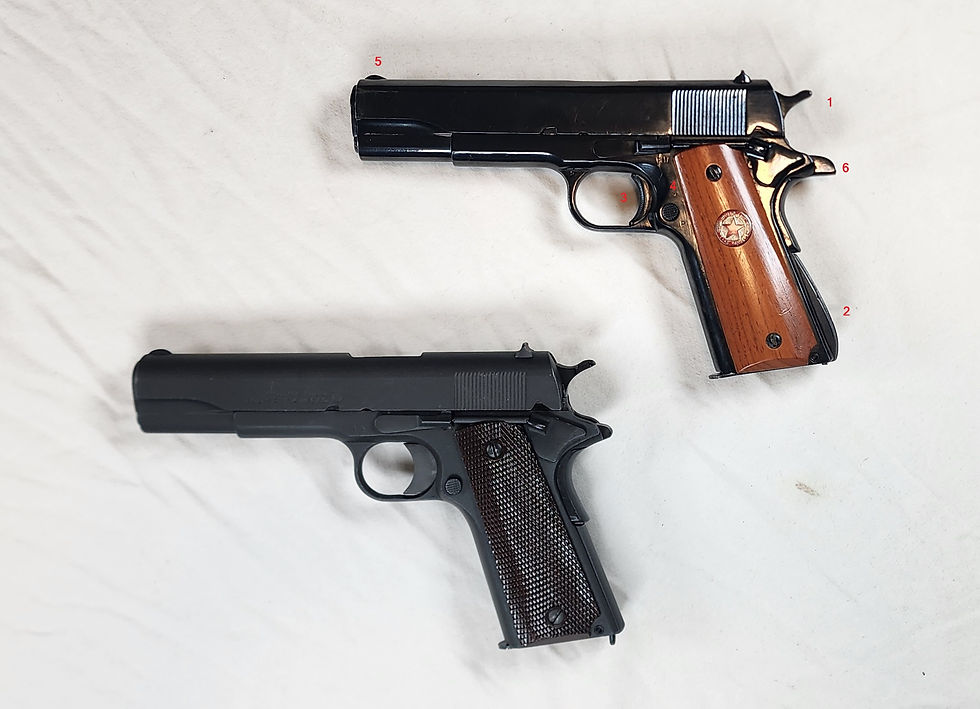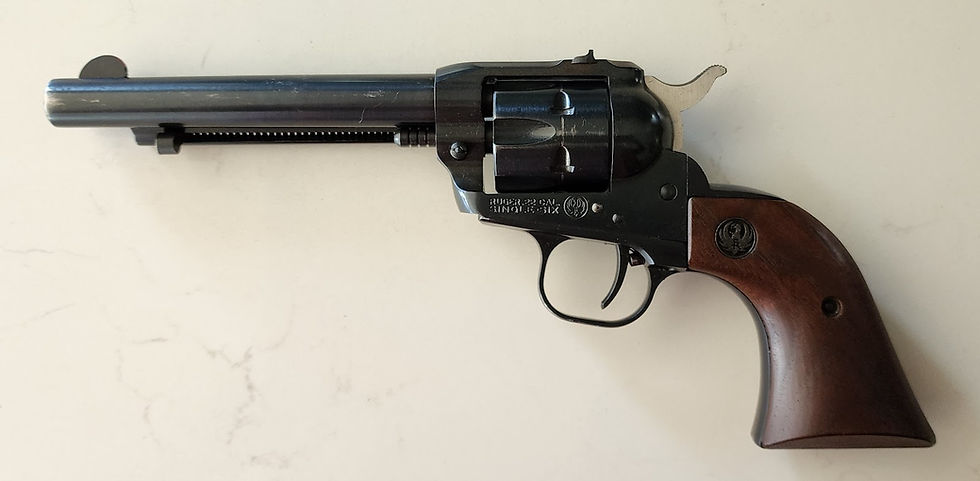1911 vs. 1911-A1: The Subtle Differences and a Gun That Lived Them
- Uncle Kenny

- Oct 27
- 4 min read
Every time I pick up a 1911, I’m taken straight back to my Army days. There’s something about that all steel frame, the clean break of the trigger, and the smell of good oil that pulls you through time. I first qualified on the 1911 in uniform, and it set the standard for everything I’ve shot since.
The 1911 has a feel that’s hard to explain unless you’ve spent time with one. It’s not just a pistol, it’s history you can hold. The one you see in the photo here isn’t just any sidearm. It’s my personal 1943 1911-A1, and like me, it’s lived one hell of a life.

The Story Behind My 1911-A1
This pistol rolled off the line in 1943 and was sent to an armory in Germany during World War II, where it saw its first issue. After the war, it was reissued to a Marine heading for Korea. When that Marine came home to Texas, he managed to procure it legally upon discharge.
That same Marine was later accepted into the Texas Rangers, and he carried this 1911-A1 as his sidearm for years. He had the Parkerized finish removed, reblued the steel, and fitted it with Ranger-style grips, turning a government issue pistol into a personal companion.
Years later, my buddy Mike married a girl from Texas who just happened to live next door to that retired Ranger. The Ranger passed the gun on to Mike before he shipped out to Vietnam. Mike served as a Special Forces LRRP Ranger, carrying that same 1911-A1 through two tours in the jungle.
When he got back, he handed it off to our late friend Doug, a dog handler who carried it through his deployment in Algeria. When Doug returned home, he passed it to me, and that’s the same pistol you’re looking at today.
That old Colt’s been across three wars, a Ranger’s belt, and more miles than most men.
Every mark tells a story.
From 1911 to 1911-A1, Subtle but Significant
The 1911 first saw service in 1911 (hence the name), designed by the great John Browning. It was simple, rugged, and powerful, chambered in .45 ACP and built to last. By the time World War II rolled around, the Army had learned a few lessons and made some refinements, creating what we now call the 1911-A1.
Here’s what changed:
The Hammer Spur
The original 1911 had a long, sharp hammer spur that had a bad habit of biting the web of your hand if you weren’t careful. The 1911A1 shortened it slightly, a small change that saved a lot of skin.
The Mainspring Housing
The 1911’s housing was flat, which worked fine for most hands, but the A1 switched to an arched housing. It brought the muzzle up just a touch and made the grip angle more natural for many soldiers.
The Trigger
The original 1911 used a long trigger, while the A1 shortened it to help soldiers with smaller hands maintain proper control.
The Trigger Contour & Frame Relief Cuts
The A1 added finger relief cuts behind the trigger guard, making it easier to reach the trigger. Subtle, but it made a difference during long qualification days on the range.
The Front Sight
Early 1911s had tiny front sights, fine for bullseye shooters, but hard to see under stress. The A1 introduced a taller, more visible sight, a big improvement for combat conditions.
The Grip Safety
On the 1911A1 was slightly lengthened and reshaped to prevent hammer bite and provide a smoother feel in the hand, a small change that made a big difference in comfort during long days on the range.
The Grips
The two 1911s in the photo both wear aftermarket grips (The Texas Ranges Star) , but originally, the 1911 sported walnut panels with a diamond pattern around the screws. The A1 replaced those with simpler checkered grips, better for mass production.
These changes might seem minor to the untrained eye, but they show how the U.S. military refined one of the most iconic pistols ever made through real battlefield experience.

What It Means to Me
When I hold my 1911-A1, I’m not just holding a firearm, I’m holding generations of service, grit, and craftsmanship. It’s been through wars, carried by men who understood the weight of duty and the value of reliability.
The 1911 and the 1911-A1 aren’t just different models. They’re different chapters in the same story, a story of how America builds, adapts, and never forgets what works.
This old pistol has seen it all. It’s not a safe queen, it’s a survivor. And as long as I’m around, it’ll stay that way.
Final Word from Uncle Kenny
If you ever get the chance to shoot both a 1911 and a 1911-A1, do it. You’ll feel the evolution, the small refinements born from hard lessons and long service. The 1911-A1 might be the polished soldier, but the 1911 is the one that started it all.
This old 1911-A1 isn’t just a fine pistol; it’s a reminder of the men who carried it before me. My late friend Doug was the last one to hold it before passing it on to me. He trusted me to keep it, and I’ve done my best to honor that. Every time I take it out of its spot next to my recliner, I think about Doug, Mike, and the others who carried it through the kind of times that test a man.
If you ever come across a gun like this, one that’s got stories etched deep into its steel, take a moment to listen. That’s history talking, and for some of us, it’s also the voice of old friends we’ll never forget.
Now that I’ve told the story, I think I’ll pour myself a glass (or three) of whiskey, in Doug’s memory, and for all the good men who carried this old Colt before me. Some stories deserve to be told, and some memories deserve a quiet toast.






Another great story uncle Kenny.. I’ve never known anyone who owned a firearm with that much history behind it, at least that they knew about.
I believe I carried one when I was in the Air Force Air Police but never knew it’s history. Thanks for the history lesson.